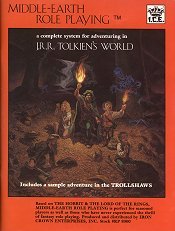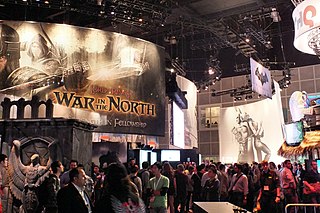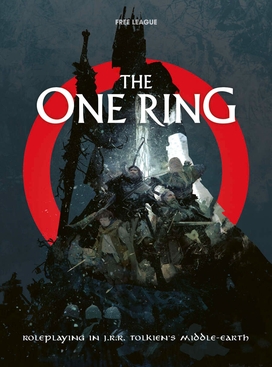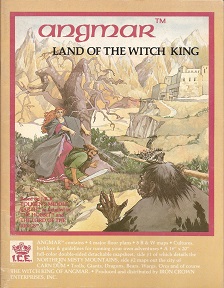
The Ringworld science fiction role-playing game was published by Chaosium in 1984, using the Basic Role-Playing system for its rules and Larry Niven's Ringworld novels as a setting.

Middle-earth Role Playing (MERP) is a 1984 tabletop role-playing game based on J. R. R. Tolkien'sThe Lord of the Rings and The Hobbit under license from Tolkien Enterprises. Iron Crown Enterprises (I.C.E.) published the game until they lost the license on 22 September 1999.

Iron Crown Enterprises (ICE) is a publishing company that has produced role playing, board, miniature, and collectible card games since 1980. Many of ICE's better-known products were related to J. R. R. Tolkien's world of Middle-earth, but the Rolemaster rules system, and its science-fiction equivalent, Space Master, have been the foundation of ICE's business.

The Lord of the Rings Roleplaying Game, released by Decipher, Inc. in 2002, is a tabletop role-playing game set in the fictional world of Middle-earth created by J. R. R. Tolkien. The game is set in the years between The Hobbit and The Fellowship of the Ring, but may be run at any time from the First to Fourth Age and contains many examples of how to do so. Sourcebooks cover the events of The Lord of the Rings and Peter Jackson's film trilogy adaptation.
Elendor is a free online text-based multi-user game that simulates the environment of J. R. R. Tolkien's Middle-earth. Users create characters by determining species, sex, culture, description, history and then role-playing with other users within the setting and atmosphere of Tolkien's world. For the purposes of consistency, the game accepts The Lord of the Rings, The Hobbit and The Silmarillion and to a lesser extent the other works of Tolkien as canonical materials. The time frame is shortly before the onset of the main events of The Lord of the Rings with Bilbo having gone to Rivendell. The game is run on a MUSH server using a variant of PennMUSH.

Middle-earth Enterprises, formerly known as Tolkien Enterprises, is a subdivision of the Embracer Freemode division of Embracer Group and formerly a trade name for a division of The Saul Zaentz Company. The subdivision owns the worldwide exclusive rights to certain elements of J. R. R. Tolkien's two most famous literary works: The Hobbit and The Lord of the Rings. These elements include the names of characters contained within as well as the names of places, objects and events within them, and certain short phrases and sayings from the works.

Middle-earth Collectible Card Game (MECCG) is an out-of-print collectible card game released by Iron Crown Enterprises in late 1995. It is the first CCG based on J.R.R. Tolkien's fictional universe of Middle-earth, with added content from ICE's Middle-earth Role Playing Game.

Lord of the Rings is a cooperative board game based on the high fantasy novel The Lord of the Rings by J. R. R. Tolkien. Published in 2000 by Kosmos in Germany, Wizards of the Coast in the U.S., and Parker Brothers in the U.K., the game is designed by Reiner Knizia and features artwork by illustrator John Howe. In the game, each player plays a hobbit in the party, and the party will aim to destroy the One Ring. Upon its release, the game received a Spiel des Jahres special award. A slightly revised version was later published by Fantasy Flight Games.

There are many video games that have been inspired by J. R. R. Tolkien's works set in Middle-earth. Titles have been produced by studios such as Electronic Arts, Vivendi Games, Melbourne House, and Warner Bros. Interactive Entertainment.
Middle-Earth Play-By-Mail, is a turn-based, strategy play by email and play-by-mail game set in the world of The Lord of the Rings and The Hobbit, including elements from ICE's Middle-earth Role Playing under licence, now run by GSI.
John D. Rateliff is an American independent scholar of fantasy literature and author of roleplaying games. He specializes in the study of the works of J. R. R. Tolkien, particularly his Middle-earth writings, and wrote and edited the 2007 book The History of the Hobbit.

The One Ring Roleplaying Game is a tabletop role-playing game set in J. R. R. Tolkien's Middle-earth, set at the time between The Hobbit and The Lord of the Rings. Designed by Francesco Nepitello and Marco Maggi, the game was initially published by Cubicle 7 in 2011 under the title The One Ring: Adventures over the Edge of the Wild. Cubicle 7 continued to publish the first edition of the game until 2019. Nepitello and Maggi developed the second edition, which is published by Free League Publishing under the same title, The One Ring Roleplaying Game.
Chris Seeman is a professor of theology and role-playing game author.

Adventures in Middle-Earth is a tabletop role-playing game originally published by Cubicle 7 in 2016 that uses the milieu of J.R.R. Tolkien's fantasy trilogy The Lord of the Rings.

Angmar: Land of the Witch King is a fantasy role-playing sourcebook published by Iron Crown Enterprises (I.C.E.) in 1982 based on J.R.R. Tolkien's The Lord of the Rings trilogy. The book expands upon Tolkien's few brief mentions of Angmar, an evil kingdom, providing gamemasters with enough material to create a setting in which player characters can experience Angmar.

Ents of Fangorn is a supplement published by Iron Crown Enterprises in 1987 for Middle-earth Role Playing (MERP), a fantasy role-playing game based on J.R.R. Tolkien's The Lord of the Rings.

Lórien & The Halls of the Elven Smiths is a supplement published by Iron Crown Enterprises (ICE) in 1986 for the fantasy role-playing game Middle-earth Role Playing, which is itself based on the works of J.R.R. Tolkien.

Trolls of the Misty Mountains is a supplement published by Iron Crown Enterprises (ICE) in 1986 for the fantasy role-playing game Middle-earth Role Playing (MERP), which is itself based on the works of J.R.R. Tolkien.

Minas Tirith is a sourcebook published by Iron Crown Enterprises (ICE) in 1988 as part of its series "Cities of Middle-earth". The book provides details about the city of Minas Tirith for use with the game Middle-earth Role Playing (MERP), itself based on the epic trilogy Lord of the Rings by J.R.R. Tolkien.















